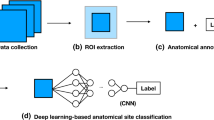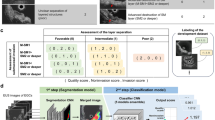Abstract
Background
Digital single‐operator cholangioscopy (DSOC) (SpyGlass DS™, Boston Scientific, MA, USA) allows for high‐definition imaging of the biliary tree. The superior visualization has led to the development of two different sets of criteria to evaluate and classify indeterminate biliary strictures: the Monaco criteria and the criteria in Carlos Robles–Medranda’s publication (CRM). Our objective was to assess the interrater agreement (IA) of DSOC interpretation for indeterminate biliary strictures using the two newly published criteria.
Methods
Forty de‐identified DSOC video recordings were sent to 15 interventional endoscopists with experience in cholangioscopy. They were asked to score the videos based on the presence of Monaco Classification criteria: stricture, lesion, mucosal changes, papillary projections, ulceration, white linear bands or rings, and vessels. Next, they scored the videos using CRM criteria: villous pattern, polypoid pattern, inflammatory pattern, flat pattern, ulcerate pattern and honeycomb pattern. The endoscopists then diagnosed the recordings as neoplastic or non-neoplastic based on the criteria. Intraclass correlation (ICC) analysis was done to evaluate interrater agreement for both criteria set and final diagnosis.
Results
Recordings of 26 malignant lesions and 14 benign lesions were scored. The IA using both the Monaco criteria and CRM criteria ranged from poor to excellent (range 0.1–0.76) and (range 0.1–0.62), respectively. Within the Monaco criteria, IA was excellent for lesion (0.75) and fingerlike papillary projections (0.74); good for tortuous vessels (0.7), mucosal features (0.62), uniform papillary projections (0.53), and ulceration (0.58); and fair for white linear bands (0.4). Within the CRM criteria, the IA was good for villous pattern (0.62), flat pattern (0.62), and honeycomb pattern; fair for ulcerated pattern (0.56), polypoid pattern (0.52) and inflammatory pattern (0.54). The diagnostic IA using Monaco criteria was good (0.65), while the diagnostic IA using CRM was fair (0.58). The overall diagnostic accuracy using the Monaco classification was 61% and CRM criteria were 57%.
Conclusion
The IOA and accuracy rate of DSOC using visual criteria from both Monaco Criteria and CRM are similar. However, some criteria from both sets suffer from poor IA, thus affecting the overall diagnostic accuracy. More formal training and refinements in visual criteria with additional validation are needed to improve diagnostic accuracy.
Trial Registration
ClinicalTrials.gov Identifier: NCT02166099.




Similar content being viewed by others
References
Heller MT, Borhani AA, Furlan A, Tublin ME. Biliary strictures and masses: an expanded differential diagnosis. Abdom Imaging 2015;40:1944–1960.
Udayakumar N, Basile N, Vennisvasanth L et al. Comparative effectiveness of biliary brush cytology and intraductal biopsy for detection of malignant biliary strictures: a systematic review and meta-analysis. Gastrointest Endosc 2015;81:168–176.
DeOliveira M, Cunningham SC, Cameron JL et al. Cholangiocarcinoma: thirty-one-year experience with 564 patients at a single institution. Ann Surg 2007;245:755–762.
Doherty B, Nambudiri VE, Palmer WC. Update on the diagnosis and treatment of cholangiocarcinoma. Curr Gastroenterol Rep 2017;19:2.
Bowlus CL, Olson KA, Gershwin ME. Evaluation of indeterminate biliary strictures. Nat Rev Gastroenterol Hepatol 2017;14:749.
Tummala P, Munigala S, Eloubeidi MA, Agarwal B. Patients with obstructive jaundice and biliary stricture +/- mass lesion on imaging: prevalence of malignancy and potential role of EUS-FNA. J Clin Gastroenterol 2013;47:532–537.
Mansfield JC, Griffin SM, Wadehra V, Matthewson K. A prospective evaluation of cytology from biliary strictures. Gut 1997;40:671–677.
Kushnir VM, Mullady DK, Das K et al. The diagnostic yield of malignancy comparing cytology, FISH, and molecular analysis of cell free cytology brush supernatant in patients with biliary strictures undergoing endoscopic retrograde cholangiography (ERC): a prospective study. J Clin Gastroenterol 2019;53:686–692.
Brooks C, Gausman V, Kokoy-Mondragon C et al. Role of fluorescent in situ hybridization, cholangioscopic biopsies, and EUS-FNA in the evaluation of biliary strictures. Dig Dis Sci 2018;63:636–644.
Singhi AD, Nikiforova MN, Chennat J et al. Integrating next-generation sequencing to endoscopic retrograde cholangiopancreatography (ERCP)-obtained biliary specimens improves the detection and management of patients with malignant bile duct strictures. Gut 2020;69:52–61. https://doi.org/10.1136/gutjnl-2018-317817.
Puli SR, Bechtold ML, Buxbaum JL, Eloubeidi MA. How good is endoscopic ultrasound-guided fine-needle aspiration in diagnosing the correct etiology for a solid pancreatic mass? A meta-analysis and systematic review. Pancreas 2013;42:20–26.
Sadeghi A, Mohamadnejad A, Islami F et al. Diagnostic yield of EUS-guided FNA for malignant biliary stricture: a systematic review and meta-analysis. Gastrointest Endosc 2016;83:290–298.
Kjaergaard G. Competition–they wrote and won. Sygeplejersken. 1992;92:4–5.
Gerges C, Beyna T, Tang RSY et al. Digital single-operator peroral cholangioscopy-guided biopsy sampling versus ERCP-guided brushing for indeterminate biliary strictures: a prospective, randomized, multicenter trial (with video). Gastrointest Endosc 2020;91(5):1105–1113. https://doi.org/10.1016/j.gie.2019.11.025.
Navaneethan U, Hasan MK, Lourdusamy V et al. Single-operator cholangioscopy and targeted biopsies in the diagnosis of indeterminate biliary strictures: a systematic review. Gastrointest Endosc 2015;82:608–614.
Turowski F, Hügle U, Dormann A et al. Diagnostic and therapeutic single-operator cholangiopancreatoscopy with SpyGlassDS: results of a multicenter retrospective cohort study. Surg Endosc 2018;32:3981–3988.
Robles-Medranda C, Valero M, Soria-Alcivar M et al. Reliability and accuracy of a novel classification system using peroral cholangioscopy for the diagnosis of bile duct lesions. Endoscopy 2018;50:1059–1070.
Sethi A, Tyberg A, Slivka A et al. Digital Single-operator Cholangioscopy (DSOC) Improves interobserver agreement (IOA) and accuracy for evaluation of indeterminate biliary strictures: the Monaco classification. J Clin Gastroenterol 2020. (Epub ahead of print). https://doi.org/10.1097/MCG.0000000000001321.
Kim HJ, Kim MH, Lee SK et al. Tumor vessel: a valuable cholangioscopic clue of malignant biliary stricture. Gastrointest Endosc 2000;52:635–638.
Parsa A, Khashab MA. The role of peroral cholangioscopy in evaluating indeterminate biliary strictures. Clin Endosc 2019;52:556–564.
Cicchetti DV. Guidelines, criteria, and rules of thumb for evaluating normed and standardized assessment instruments in psychology. Psychol Assess 1994;6:284–290. https://doi.org/10.1037/1040-3590.6.4.284.
Author information
Authors and Affiliations
Corresponding author
Ethics declarations
Conflict of interest
Amy Tyberg: Consultant for Ninepoint Medical, Endogastric Solutions, Obalon Therapeutics. She is a director of Therapeutic Endoscopic Ultrasound society. Adam Slivka, Divyesh Sejpal, Raj Shah: Consultant for Boston Scientific and Olympus Medical. Douglas G Adler: Consultant for Boston Scientific. Isaac Raijman: Speaker for Boston Scientific, ConMed, Medtronic and GI Supplies. He is on the advisory board of Microtech. And he is a coowner of EndoRx. Paul Tarnasky, Prashant Kedia: Consultant and speaker for Boston Scientific. Michel Kahaleh: Consulting work for Boston Scientific, Interscope Med, ERBE, Medrobotic and AbbVie. He has received research grants from Boston Scientific, Conmed, Pinnacle, Cook, Gore, Merit, and Olympus. He is the CEO and Founder of Innovative Digestive Health Education & Research Inc., and Therapeutic Endoscopic Ultrasound Society. Monica Gaidhane: Consulting work for Interscope Med and Capvision. She is the COO of Therapeutic Endoscopic Ultrasound Society and Innovative Digestive Health Education & Research Inc. Avik Sarkar: Director of Obesity Coalition Inc. The remaining authors declare that they have nothing to disclose.
Additional information
Publisher's Note
Springer Nature remains neutral with regard to jurisdictional claims in published maps and institutional affiliations.
This project was presented as a poster at United European Gastroenterology (UEG) Week 2019 Vienna.
Rights and permissions
About this article
Cite this article
Kahaleh, M., Raijman, I., Gaidhane, M. et al. Digital Cholangioscopic Interpretation: When North Meets the South. Dig Dis Sci 67, 1345–1351 (2022). https://doi.org/10.1007/s10620-021-06961-z
Received:
Accepted:
Published:
Issue Date:
DOI: https://doi.org/10.1007/s10620-021-06961-z




